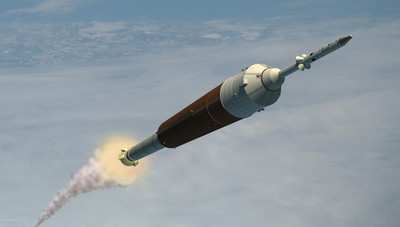Manned Spaceflight's Effect On Environmetal Under Scrutiny
 NASA has issued a draft
environmental impact statement on potential environmental impacts
associated with the agency's upcoming Constellation manned
spaceflight program, intended to return humans to the moon by 2020.
The agency says its Draft Programmatic Environmental Impact
Statement concludes localized and global environmental impacts
associated with implementing the Constellation Program would be
comparable to past or ongoing NASA activities.
NASA has issued a draft
environmental impact statement on potential environmental impacts
associated with the agency's upcoming Constellation manned
spaceflight program, intended to return humans to the moon by 2020.
The agency says its Draft Programmatic Environmental Impact
Statement concludes localized and global environmental impacts
associated with implementing the Constellation Program would be
comparable to past or ongoing NASA activities.
The National Environmental Policy Act requires federal agencies
to prepare an environmental impact statement for major federal
actions that may significantly affect the quality of the human
environment. Federal agencies must consider potential environmental
impacts of their proposed actions before deciding whether and how
to proceed.
This draft examines the effects of development, testing and
operation of spacecraft and support systems associated with
Constellation Program activities through the early 2020s. NASA
plans to use multiple government and contractor facilities in
implementing the program.
The spacecraft to be developed include the Orion crew
exploration vehicle, the Ares I crew launch vehicle, the Ares V
cargo launch vehicle, the lunar lander, and other cargo systems.
Orion, launched atop the Ares I, would be capable of docking with
the International Space Station or with cargo launched to low Earth
orbit by the Ares V for transit to the moon or future missions to
Mars.

Since the Constellation Program will be based largely upon
components and facilities used in the Space Shuttle Program, the
potential environmental impacts are expected to be similar. The
principal activities associated with Constellation that could
result in potential environmental impacts include rocket engine
tests, rocket launches, construction of new facilities and
modifications to existing facilities.
In preparing this draft, NASA published a notice of intent in
the Federal Register on September 26, 2006. NASA held public
scoping meetings to invite input on environmental concerns of
program alternatives on October 18, 2006, in Cocoa, FL; on October
20, 2006, in Washington; and on October 24, 2006, in Salt Lake
City. NASA also solicited comments from federal, state, and local
agencies and other interested parties. The public scoping period
ended November 13, 2006.
Publicly identified issues resulting from the scoping meetings
include the economic impact of the Constellation Program on local
jobs near NASA centers, risks to the public through launch and
reentry of the Orion spacecraft, noise associated with launch
events and impacts to animal species in the Kennedy Space Center,
FL area from construction and launch activities. Other issues
included the socio-economic impacts of decommissioning the space
shuttle and implementing the Constellation Program.

NASA will accept public comments on the Draft Programmatic
Environmental Impact Statement through September 2007. The final
environmental impact statement is expected to be complete by Spring
2008. An appendix in the final statement will include public
comments and NASA's responses. NASA expects to provide a formal
record of decision for the Constellation Program in late Spring
2008.
 Bolen Gives Congress a Rare Thumbs-Up
Bolen Gives Congress a Rare Thumbs-Up The SportPlane Resource Guide RETURNS!!!!
The SportPlane Resource Guide RETURNS!!!! Buying Sprees Continue: Textron eAviation Takes On Amazilia Aerospace
Buying Sprees Continue: Textron eAviation Takes On Amazilia Aerospace Hawker 4000 Bizjets Gain Nav System, Data Link STC
Hawker 4000 Bizjets Gain Nav System, Data Link STC Echodyne Gets BVLOS Waiver for AiRanger Aircraft
Echodyne Gets BVLOS Waiver for AiRanger Aircraft





